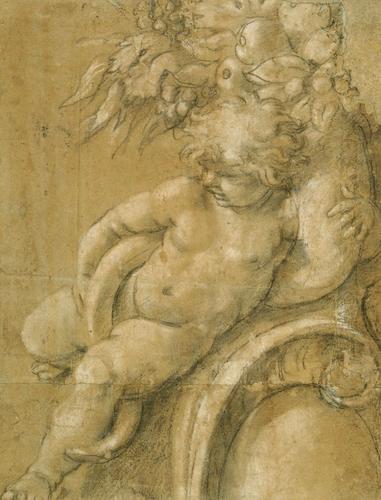A cartoon of a putto with a cornucopia c.1596
Black and white chalks on two sheets of dirty brown paper, the outlines partly incised | 52.8 x 39.6 cm (sheet of paper) | RCIN 902024
-
Annibale Carracci left Bologna in 1595 to work for Cardinal Odoardo Farnese in Rome. His first project there was to fresco the ceiling of Odoardo’s study, the Camerino in Palazzo Farnese, with scenes from myth and legend in a decorative surround. This was the full-scale working cartoon for a putto supporting a shield bearing an allegorical figure. Annibale Carracci’s frescoes in the Palazzo Farnese, Rome, were the defining projects of his life. His decoration of the Galleria was the seminal work of the Baroque in the city, and broke him as an artist and a man. But before he began work in the Galleria he frescoed the adjoining Camerino, a relatively small room measuring 4.8 x 9.4 m (about 15 x 30 ft), probably Cardinal Odoardo Farnese’s study. The young Odoardo had begun negotiations to bring the Carracci to Rome in 1593. Annibale and his brother travelled south to sign a contract the following year, and after returning to sort his affairs in Bologna, Annibale arrived in Rome, alone, in the autumn of 1595.
Odoardo Farnese had first intended to have the Sala Grande of the palace frescoed with scenes from the life of his father, Alessandro, but this scheme was put in abeyance, and Annibale began work instead on the Camerino, completing that room by early 1597 Odoardo Farnese had corresponded with his librarian, Fulvio Orsini, during the summer of 1595 about the decorative programme for the room. At the centre of the coved ceiling was a large rectangular canvas of the Choice of Hercules (now in Capodimonte, Naples), flanked on the long sides by two oval frescoes also on the theme of Hercules, and on the short sides by roundels with the Farnese emblem of lilies. The perimeter of the ceiling is punctuated by six triangular spandrels curving over lunettes, two on each long wall and one on each short wall; the lunettes depict scenes from the stories of Odysseus, Perseus, and the Catanian brothers. The remainder of the vault is symmetrically divided by gilded stucco mouldings into a number of irregular fields, each frescoed with a monochrome arrangement of putti, sirens, satyrs, acanthus scrolls, masks, birds and decorative frameworks housing allegorical figures.
This full-scale cartoon corresponds in most respects with the putti flanking the figures of Chastity (above the lunette of Odysseus and Circe) and Intelligence (above Odysseus and the Sirens) in the triangular spandrels at either end of the room. However it is questionable whether the cartoon was actually used for transfer to the fresco surface: it does not correspond exactly with the paintings, in which the legs of the putto are longer, the frames are a simple oval (rather than the complex cartouche seen here), and the cornucopias interlock so that each putto grasps that of his neighbour. While the outlines of the cartoon are partly incised with a knife, some of these lines are of details that were not painted, primarily the cartouche. A contiguous cartoon for the siren in the same decorative field, also at Windsor, is likewise partially incised, again including the unpainted cartouche. That cartoon is joined to a fragment of another, for the heads of putti in the corners of the side-spandrels, which is pricked in great detail along its outlines. Close examination of the fresco itself would be required to resolve this complicated situation, but it would appear, whatever the scenario, that Annibale’s execution of the ceiling of the Camerino did not proceed in an orderly fashion, and that there was substantial revision of the scheme even as the artist was preparing the cartoons.
This cartoon and its companion were described by Vincenzo Vittoria in Carlo Maratti’s collection: un pezzo di cartone di una sirena della nave di Ulisse, & un altro di un putto, che si vede negli ornamenti ... tutti di Annibale. The cartoon has thus been identified with that listed in the 1664 inventory of Domenichino’s heir, Francesco Raspantino, among one many Chartoni di mano del Caracci, as a Chartone d’un Putto con fogliami, though as the companion piece of the siren does not seem to appear in that inventory some doubt remains about this identification.
Catalogue entry adapted from The Art of Italy in the Royal Collection: Renaissance and Baroque, London, 2007Provenance
Purchased by George III
-
Medium and techniques
Black and white chalks on two sheets of dirty brown paper, the outlines partly incised
Measurements
52.8 x 39.6 cm (sheet of paper)
Object type(s)
Other number(s)
RL 02024











